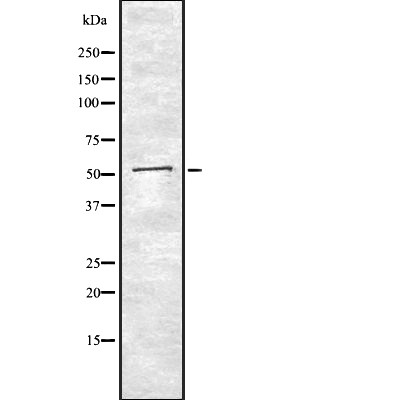AGT Antibody - #DF7976
| Product: | AGT Antibody |
| Catalog: | DF7976 |
| Description: | Rabbit polyclonal antibody to AGT |
| Application: | WB IHC |
| Reactivity: | Human, Mouse |
| Mol.Wt.: | 53 kDa; 53kD(Calculated). |
| Uniprot: | P01019 |
| RRID: | AB_2841364 |
Related Downloads
Protocols
Product Info
*The optimal dilutions should be determined by the end user. For optimal experimental results, antibody reuse is not recommended.
*Tips:
WB: For western blot detection of denatured protein samples. IHC: For immunohistochemical detection of paraffin sections (IHC-p) or frozen sections (IHC-f) of tissue samples. IF/ICC: For immunofluorescence detection of cell samples. ELISA(peptide): For ELISA detection of antigenic peptide.
Cite Format: Affinity Biosciences Cat# DF7976, RRID:AB_2841364.
Fold/Unfold
Aangiotensinogen (serpin peptidase inhibitor clade A member 8); AGT; AI265500; Alpha 1 antiproteinase antitrypsin; Ang; Ang I; Ang II; Ang III; AngII; Angiotensin I; Angiotensin II; Angiotensin III; Angiotensin-3; Angiotensinogen (PAT); Angiotensinogen; ANGT_HUMAN; ANHU; ANRT; AT-2; AT-II; Des-Asp[1]-angiotensin II; FLJ92595; FLJ97926; MGC105326; PAT; Pre angiotensinogen; Serine (or cysteine) proteinase inhibitor; Serpin A8; Serpin peptidase inhibitor clade A member 8; SERPINA8;
Immunogens
A synthesized peptide derived from human AGT, corresponding to a region within N-terminal amino acids.
- P01019 ANGT_HUMAN:
- Protein BLAST With
- NCBI/
- ExPASy/
- Uniprot
MRKRAPQSEMAPAGVSLRATILCLLAWAGLAAGDRVYIHPFHLVIHNESTCEQLAKANAGKPKDPTFIPAPIQAKTSPVDEKALQDQLVLVAAKLDTEDKLRAAMVGMLANFLGFRIYGMHSELWGVVHGATVLSPTAVFGTLASLYLGALDHTADRLQAILGVPWKDKNCTSRLDAHKVLSALQAVQGLLVAQGRADSQAQLLLSTVVGVFTAPGLHLKQPFVQGLALYTPVVLPRSLDFTELDVAAEKIDRFMQAVTGWKTGCSLMGASVDSTLAFNTYVHFQGKMKGFSLLAEPQEFWVDNSTSVSVPMLSGMGTFQHWSDIQDNFSVTQVPFTESACLLLIQPHYASDLDKVEGLTFQQNSLNWMKKLSPRTIHLTMPQLVLQGSYDLQDLLAQAELPAILHTELNLQKLSNDRIRVGEVLNSIFFELEADEREPTESTQQLNKPEVLEVTLNRPFLFAVYDQSATALHFLGRVANPLSTA
Research Backgrounds
Essential component of the renin-angiotensin system (RAS), a potent regulator of blood pressure, body fluid and electrolyte homeostasis.
acts directly on vascular smooth muscle as a potent vasoconstrictor, affects cardiac contractility and heart rate through its action on the sympathetic nervous system, and alters renal sodium and water absorption through its ability to stimulate the zona glomerulosa cells of the adrenal cortex to synthesize and secrete aldosterone.
stimulates aldosterone release.
is a ligand for the G-protein coupled receptor MAS1. Has vasodilator and antidiuretic effects. Has an antithrombotic effect that involves MAS1-mediated release of nitric oxide from platelets.
Beta-decarboxylation of Asp-34 in angiotensin-2, by mononuclear leukocytes produces alanine. The resulting peptide form, angiotensin-A, has the same affinity for the AT1 receptor as angiotensin-2, but a higher affinity for the AT2 receptor.
In response to low blood pressure, the enzyme renin/REN cleaves angiotensinogen to produce angiotensin-1. Angiotensin-1 is a substrate of ACE (angiotensin converting enzyme) that removes a dipeptide to yield the physiologically active peptide angiotensin-2. Angiotensin-1 and angiotensin-2 can be further processed to generate angiotensin-3, angiotensin-4. Angiotensin 1-9 is cleaved from angiotensin-1 by ACE2 and can be further processed by ACE to produce angiotensin 1-7, angiotensin 1-5 and angiotensin 1-4. Angiotensin 1-7 has also been proposed to be cleaved from angiotensin-2 by ACE2 or from angiotensin-1 by MME (neprilysin).
The disulfide bond is labile. Angiotensinogen is present in the circulation in a near 40:60 ratio with the oxidized disulfide-bonded form, which preferentially interacts with receptor-bound renin.
Secreted.
Expressed by the liver and secreted in plasma.
Belongs to the serpin family.
Research Fields
· Organismal Systems > Endocrine system > Renin-angiotensin system. (View pathway)
· Organismal Systems > Endocrine system > Renin secretion.
Restrictive clause
Affinity Biosciences tests all products strictly. Citations are provided as a resource for additional applications that have not been validated by Affinity Biosciences. Please choose the appropriate format for each application and consult Materials and Methods sections for additional details about the use of any product in these publications.
For Research Use Only.
Not for use in diagnostic or therapeutic procedures. Not for resale. Not for distribution without written consent. Affinity Biosciences will not be held responsible for patent infringement or other violations that may occur with the use of our products. Affinity Biosciences, Affinity Biosciences Logo and all other trademarks are the property of Affinity Biosciences LTD.


